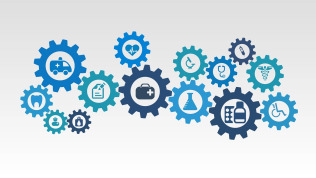Customer feedback is a critical piece of any commercial relationship, and its impact in health IT can be particularly valuable – but timing is everything. For other industries, customer feedback surveys and Likert scales at the end of a project may be effective means of measuring satisfaction. In healthcare, this type of qualitative feedback is often too little too late. IT vendors need to evaluate the customer’s perception of the product and its value at each stage of integration. Continue reading
customer feedback surveys and Likert scales at the end of a project may be effective means of measuring satisfaction. In healthcare, this type of qualitative feedback is often too little too late. IT vendors need to evaluate the customer’s perception of the product and its value at each stage of integration. Continue reading
Tag Archives: AirStrip
Nurses: The Force for Change
 This week marks National Nurses Week in the U.S., both a celebration of the profession and an opportunity to educate the public about the role nurses play in healthcare and their communities. This year’s theme of “Nurses: Inspire, Innovate, Influence” highlights three concepts that overlap and reflect the innate role nurses play in patient care, as well as drawing attention to the personality types often drawn to nursing.
This week marks National Nurses Week in the U.S., both a celebration of the profession and an opportunity to educate the public about the role nurses play in healthcare and their communities. This year’s theme of “Nurses: Inspire, Innovate, Influence” highlights three concepts that overlap and reflect the innate role nurses play in patient care, as well as drawing attention to the personality types often drawn to nursing.
Unifying the Healthcare Assembly Line
 Driving toward value-based care first requires a healthy understanding of the environment in which we are operating. Though regularly criticized, the U.S. healthcare system is actually strong: we have some of the world’s best hospitals and doctors. Individual service lines can provide attentive and effective care, whether it is cardiology, endocrinology or oncology.
Driving toward value-based care first requires a healthy understanding of the environment in which we are operating. Though regularly criticized, the U.S. healthcare system is actually strong: we have some of the world’s best hospitals and doctors. Individual service lines can provide attentive and effective care, whether it is cardiology, endocrinology or oncology.
However, we are falling short by failing to pull these service lines together. That is where the challenge lies. By focusing on wellness, we have the capability to deliver collaborative care and truly transformative outcomes.
Three Ways Technology Can Address Healthcare’s Growing Pains
 Science and medicine continue to advance at an astonishing rate thanks to technological innovation. We have already seen digital health solutions that promise to transform patient care in our lifetime. While these advancements are indeed groundbreaking for the healthcare industry, there are still basic day-to-day care processes in hospitals across the country ripe for improvement by applying technology.
Science and medicine continue to advance at an astonishing rate thanks to technological innovation. We have already seen digital health solutions that promise to transform patient care in our lifetime. While these advancements are indeed groundbreaking for the healthcare industry, there are still basic day-to-day care processes in hospitals across the country ripe for improvement by applying technology.
Part Two: Our 2018 Health IT Wish List
 The healthcare IT industry enters 2018 with a lot of potential, along with the need to overcome structures that have historically stunted progress. What is on our health IT wish list? AirStrip is feeling optimistic about the industry’s direction in terms of broader collaboration for building up truly interoperable systems to improve patient care, and overall health system stability.
The healthcare IT industry enters 2018 with a lot of potential, along with the need to overcome structures that have historically stunted progress. What is on our health IT wish list? AirStrip is feeling optimistic about the industry’s direction in terms of broader collaboration for building up truly interoperable systems to improve patient care, and overall health system stability.
Part One: A Look Back on Health IT in 2017
 2017 was a roller-coaster ride for healthcare, marked by exciting innovation, damaging cyberattacks, periods of lulls and disruptive change. As we enter a new year, it is important to celebrate the industry’s successes in 2017, and reflect on the ways these changes, incidents, and regulations both pushed health IT forward and established a foundation for 2018. From the consumerization of healthcare, to the implications of a changing reimbursement structure, to increases in health IT M&A, here is what three AirStrip executives and consultants identified as the most impactful change in health IT last year:
2017 was a roller-coaster ride for healthcare, marked by exciting innovation, damaging cyberattacks, periods of lulls and disruptive change. As we enter a new year, it is important to celebrate the industry’s successes in 2017, and reflect on the ways these changes, incidents, and regulations both pushed health IT forward and established a foundation for 2018. From the consumerization of healthcare, to the implications of a changing reimbursement structure, to increases in health IT M&A, here is what three AirStrip executives and consultants identified as the most impactful change in health IT last year:
2018: Shifting Healthcare’s Mindset to the Mobile Patient
 This past year, 2017, has been a challenging year for many industries, and healthcare is certainly no exception. Not only are there major challenges connected to an increasingly aging population and outdated healthcare infrastructure, but the industry is also adapting to the policies associated with a new presidential administration. While technology will continue to be a key part of the future of healthcare, one of the biggest changes will be a shift in mindset from mobile technology to mobile patients.
This past year, 2017, has been a challenging year for many industries, and healthcare is certainly no exception. Not only are there major challenges connected to an increasingly aging population and outdated healthcare infrastructure, but the industry is also adapting to the policies associated with a new presidential administration. While technology will continue to be a key part of the future of healthcare, one of the biggest changes will be a shift in mindset from mobile technology to mobile patients.
MACRA: The Yardstick for Quality that Health Systems Need
 The number of quality initiatives is rapidly rising in the healthcare industry as stakeholders shift their focus toward the value of patient care. In addition, with the recent implementation of the Medicare Access and CHIP Reauthorization Act (MACRA), the rules surrounding healthcare reimbursement are being rewritten, incentivizing healthcare providers to prioritize the quality of patient visits over the quantity.
The number of quality initiatives is rapidly rising in the healthcare industry as stakeholders shift their focus toward the value of patient care. In addition, with the recent implementation of the Medicare Access and CHIP Reauthorization Act (MACRA), the rules surrounding healthcare reimbursement are being rewritten, incentivizing healthcare providers to prioritize the quality of patient visits over the quantity.
Historically, it has been difficult to achieve consensus on defining quality; therefore, it was not consistently measured. MACRA provides tools to assess quality of care, and lays the foundation for a future in which payers and providers must collaborate in new ways driven by patient data.
Nurse-Physician Collaboration: Harnessing the Power of Health IT to Improve Patient Outcomes
 Most physicians have long enjoyed the benefits of Bring Your Own Device (BYOD) policies. As health systems focused on ensuring doctors had access to state-of-the-art health IT to monitor their patients when they couldn’t be at the bedside, the quality of tools and pace of adoption for nursing solutions did not keep up. In some situations, nurses received bulky phones that could only be used within the walls of the hospital, while physicians needed to download specific apps on their own devices to receive calls from the nurses’ devices. Technical difficulties were frequent. In other situations, health systems tried rolling out solutions to nurses that had been used successfully by physicians. Unfortunately, those solutions were not always conducive to nurses’ workflow.
Most physicians have long enjoyed the benefits of Bring Your Own Device (BYOD) policies. As health systems focused on ensuring doctors had access to state-of-the-art health IT to monitor their patients when they couldn’t be at the bedside, the quality of tools and pace of adoption for nursing solutions did not keep up. In some situations, nurses received bulky phones that could only be used within the walls of the hospital, while physicians needed to download specific apps on their own devices to receive calls from the nurses’ devices. Technical difficulties were frequent. In other situations, health systems tried rolling out solutions to nurses that had been used successfully by physicians. Unfortunately, those solutions were not always conducive to nurses’ workflow.
Reflecting on IT’s Transformation of Healthcare
 As we celebrate National Health IT Week, it is incredible to realize how health technology tools are transforming every facet of patient care. From telehealth, to 3D printers to artificial intelligence, the explosion of personalized health devices redefines the dynamics of patient treatment and interactions.
As we celebrate National Health IT Week, it is incredible to realize how health technology tools are transforming every facet of patient care. From telehealth, to 3D printers to artificial intelligence, the explosion of personalized health devices redefines the dynamics of patient treatment and interactions.
However, we still fall short in comparison to other industries, particularly in terms of consistent patient information access, and the lack of incentive for industry collaboration to achieve smooth, interoperable data transfers. This week, we strike a balance between applauding our progress, yet refusing to rest on our laurels.
